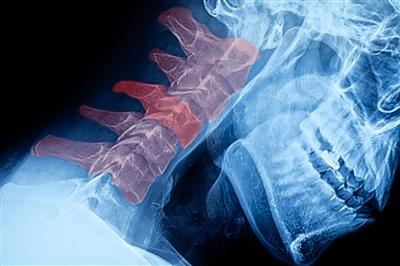Preventing tech neck in the age of Zoom

Before you read further, stop. Are you reading this on a phone? Tablet? Your smartwatch? If you are, is your neck bent down or your back hunched over as you read? This form is a telltale sign of tech neck, a fun name for a painful problem. Tech neck refers to the neck pain, strain and discomfort that often comes as a result of spending so many hours a day using electronics.
And while it’s nothing new, tech neck has certainly become a greater concern now that many of us are working from home, hosting virtual meetings and get-togethers with loved ones.
“Most of us probably don’t pay much attention to the alignment of our head, neck and spine during the day but, ideally, you should be holding your head in a neutral, relaxed position most of the day,” says Michael R. Murray, MD, a spine surgeon at Main Line Health.
To demonstrate the effects of tech neck, try holding your head up normally, as you might if you are in conversation with someone. Then begin to move your neck forward and down, tucking your chin to your chest. You’ll likely begin to feel some pain and strain in your spine, neck, shoulders and back—now consider several hours of that position!

Dr. Murray uses an analogy with his patients to convey the long-term effects of tech neck. “I ask patients to visualize holding a glass of water. When the spine is aligned, it’s like holding a glass of water close to your body—it can be done comfortably for a long period of time,” he says.
However, when the spine is out of alignment, it is like holding the full glass of water in front of you with an outstretched arm. The additional stress that this causes will make your shoulder and arm muscles start to burn from fatigue in a short period of time. If you continue with poor posture, the same thing will happen to the muscles around your spine.
The most common symptom of tech neck is, of course, neck pain and discomfort, but you might notice other aches and pains too. Headaches, shoulder pain, neck spasms and weakness or tingling in your arms as a result of a pinched nerve can also be a result of tech neck. Long term, your positioning can also cause a herniated disc or affect the curvature of your spine.
Tips to prevent tech neck
Most of us have spent the last year avoiding in person meetings, and even though we are slowly start emerging from our homes, it's clear that virtual meetings are not ending anytime soon. Therefore, it's important to manage neck pain and discomfort.
- Take a 10-minute break every hour to get up and walk around
- Take phone calls standing up
- Invest in some high-quality office furniture like a high-backed chair, standing desk, etc.
- Make time every day for exercise

After a long day, pain and discomfort may not be a concern. But if this lasts for several weeks or you’re finding it difficult to move and complete daily activities, talk to your health care provider about solutions. They may recommend physical therapy but, if your pain is severe enough, can also direct you to a spine specialist.
Main Line Health serves patients at hospitals and health centers throughout the western suburbs of Philadelphia. To schedule an appointment with a specialist at Main Line Health, call 1.866.CALL.MLH (225.5654).
 Content you want, delivered to your inbox
Content you want, delivered to your inbox
Want to get the latest health and wellness articles delivered right to your inbox?
Subscribe to the Well Ahead Newsletter.
